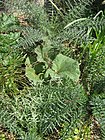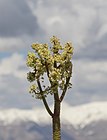Note: This is a project under development. The articles on this wiki are just being initiated and broadly incomplete. You can Help creating new pages.
Difference between revisions of "Rheum ribes - Syrian rhubarb"
(→Common names) |
|||
| (4 intermediate revisions by 2 users not shown) | |||
| Line 1: | Line 1: | ||
| − | '''Rheum ribes''' | + | [[File:Abrus precatorius W IMG 1578.jpg|thumb|right]] |
| − | + | '''Rheum ribes''' is native to Turkey, Syria, Lebanon, Iraq, Iran, Azerbaijan, Armenia to Afghanistan and Pakistan. The Syrian rhubarb a partially commercial vegetable collected from the nature in Eastern and Southern Anatolia, Northern Iraq and partly Northwestern Iran in early spring. Rheum ribes is considered as a valuable medicinal species in herbal medicine. | |
==Uses== | ==Uses== | ||
{{Uses|Heart disease}}, {{Uses|Indigestion}}, {{Uses|Bone problems}}, {{Uses|Alzheimer}}, {{Uses|Cancer}}, {{Uses|Blotches}}, {{Uses|Pimples}}, {{Uses|Diarrhea}}. | {{Uses|Heart disease}}, {{Uses|Indigestion}}, {{Uses|Bone problems}}, {{Uses|Alzheimer}}, {{Uses|Cancer}}, {{Uses|Blotches}}, {{Uses|Pimples}}, {{Uses|Diarrhea}}. | ||
| Line 8: | Line 8: | ||
==Chemical Composition== | ==Chemical Composition== | ||
| − | The hypoglycemic active fraction was found to contain anthraquinone glycosides of aloe emodin, emodin, physcion, and chrysophanol derivatives<ref name="chemical composition"/> | + | The hypoglycemic active fraction was found to contain anthraquinone glycosides of aloe emodin, emodin, physcion, and chrysophanol derivatives.<ref name="chemical composition"/> |
==Common names== | ==Common names== | ||
| Line 40: | Line 40: | ||
===Fruit=== | ===Fruit=== | ||
| − | {{Fruit||7–10 mm (0.28–0.4 in.) long pome| | + | {{Fruit||7–10 mm (0.28–0.4 in.) long pome|Clearly grooved lengthwise, Lowest hooked hairs aligned towards crown|With hooked hairs|}} |
===Other features=== | ===Other features=== | ||
==List of Ayurvedic medicine in which the herb is used== | ==List of Ayurvedic medicine in which the herb is used== | ||
| − | |||
==Where to get the saplings== | ==Where to get the saplings== | ||
| Line 52: | Line 51: | ||
==How to plant/cultivate== | ==How to plant/cultivate== | ||
| − | Prefers a deep, fertile, moderately heavy, humus rich, moisture retentive, well-drained soil in sun or semi-shade<ref name="How to plant/cultivate"/> | + | Prefers a deep, fertile, moderately heavy, humus rich, moisture retentive, well-drained soil in sun or semi-shade.<ref name="How to plant/cultivate"/> |
==Commonly seen growing in areas== | ==Commonly seen growing in areas== | ||
| − | {{Commonly seen| | + | {{Commonly seen|At dunite rocks}}, {{Commonly seen|Among stone area}}, {{Commonly seen|Among slopes area}}, {{Commonly seen|Temperate regions}}, {{Commonly seen|Subtropical regions}}. |
==Photo Gallery== | ==Photo Gallery== | ||
<gallery class="left" caption="" widths="140px" heights="140px"> | <gallery class="left" caption="" widths="140px" heights="140px"> | ||
Cynara humilis and Rheum ribes (17331318012).jpg | Cynara humilis and Rheum ribes (17331318012).jpg | ||
| − | |||
| − | |||
Rheum ribes - Işgın 01.jpg | Rheum ribes - Işgın 01.jpg | ||
| − | |||
Rheum ribes - Işgın 05.jpg | Rheum ribes - Işgın 05.jpg | ||
| − | |||
Rheum ribes - Işgın 06.jpg | Rheum ribes - Işgın 06.jpg | ||
| − | |||
| − | |||
Rheum ribes - Işgın 08.jpg | Rheum ribes - Işgın 08.jpg | ||
| − | |||
</gallery> | </gallery> | ||
| Line 76: | Line 68: | ||
<references> | <references> | ||
| − | <ref name="chemical composition">[https://www.tandfonline.com/doi/full/10.1080/13880200902748478?src=recsys | + | <ref name="chemical composition">[https://www.tandfonline.com/doi/full/10.1080/13880200902748478?src=recsys Chemical constituents]</ref> |
| − | <ref name="Leaf">[https://web.archive.org/web/20131226161459/http://www.wildflowers-guide.com/39-agrimony.html | + | <ref name="Leaf">[https://web.archive.org/web/20131226161459/http://www.wildflowers-guide.com/39-agrimony.html Wayback machine]</ref> |
| − | <ref name="How to plant/cultivate">[https://www.pfaf.org/user/Plant.aspx?LatinName=Rheum+ribes | + | <ref name="How to plant/cultivate">[https://www.pfaf.org/user/Plant.aspx?LatinName=Rheum+ribes Cultivation details]</ref> |
</references> | </references> | ||
| Line 91: | Line 83: | ||
[[Category:Herbs]] | [[Category:Herbs]] | ||
| + | [[Category:Ayurvedic herbs that don't have seed photos]] | ||
| + | [[Category:Polygonaceae]] | ||
Latest revision as of 12:21, 15 June 2020
Rheum ribes is native to Turkey, Syria, Lebanon, Iraq, Iran, Azerbaijan, Armenia to Afghanistan and Pakistan. The Syrian rhubarb a partially commercial vegetable collected from the nature in Eastern and Southern Anatolia, Northern Iraq and partly Northwestern Iran in early spring. Rheum ribes is considered as a valuable medicinal species in herbal medicine.
Contents
- 1 Uses
- 2 Parts Used
- 3 Chemical Composition
- 4 Common names
- 5 Properties
- 6 Habit
- 7 Identification
- 8 List of Ayurvedic medicine in which the herb is used
- 9 Where to get the saplings
- 10 Mode of Propagation
- 11 How to plant/cultivate
- 12 Commonly seen growing in areas
- 13 Photo Gallery
- 14 References
- 15 External Links
Uses
Heart disease, Indigestion, Bone problems, Alzheimer, Cancer, Blotches, Pimples, Diarrhea.
Parts Used
Chemical Composition
The hypoglycemic active fraction was found to contain anthraquinone glycosides of aloe emodin, emodin, physcion, and chrysophanol derivatives.[1]
Common names
| Language | Common name |
|---|---|
| Kannada | |
| Hindi | |
| Malayalam | |
| Tamil | |
| Telugu | |
| Marathi | NA |
| Gujarathi | NA |
| Punjabi | NA |
| Kashmiri | NA |
| Sanskrit | |
| English | Syrian rhubarb |
Properties
Reference: Dravya - Substance, Rasa - Taste, Guna - Qualities, Veerya - Potency, Vipaka - Post-digesion effect, Karma - Pharmacological activity, Prabhava - Therepeutics.
Dravya
Rasa
Tikta (Bitter), Kashaya (Astringent)
Guna
Laghu (Light), Ruksha (Dry), Tikshna (Sharp)
Veerya
Ushna (Hot)
Vipaka
Katu (Pungent)
Karma
Kapha, Vata
Prabhava
Habit
Identification
Leaf
| Kind | Shape | Feature |
|---|---|---|
| Simple | The leaves are divided into 3-6 toothed leaflets, with smaller leaflets in between |
Flower
| Type | Size | Color and composition | Stamen | More information |
|---|---|---|---|---|
| Unisexual | 2-4cm long | Yellow | 5-20 | Flowers Season is June - August |
Fruit
| Type | Size | Mass | Appearance | Seeds | More information |
|---|---|---|---|---|---|
| 7–10 mm (0.28–0.4 in.) long pome | Clearly grooved lengthwise, Lowest hooked hairs aligned towards crown | With hooked hairs | {{{6}}} |
Other features
List of Ayurvedic medicine in which the herb is used
Where to get the saplings
Mode of Propagation
How to plant/cultivate
Prefers a deep, fertile, moderately heavy, humus rich, moisture retentive, well-drained soil in sun or semi-shade.[3]
Commonly seen growing in areas
At dunite rocks, Among stone area, Among slopes area, Temperate regions, Subtropical regions.
Photo Gallery
References
External Links
- Ayurvedic Herbs known to be helpful to treat Heart disease
- Ayurvedic Herbs known to be helpful to treat Indigestion
- Ayurvedic Herbs known to be helpful to treat Bone problems
- Ayurvedic Herbs known to be helpful to treat Alzheimer
- Ayurvedic Herbs known to be helpful to treat Cancer
- Ayurvedic Herbs known to be helpful to treat Blotches
- Ayurvedic Herbs known to be helpful to treat Pimples
- Ayurvedic Herbs known to be helpful to treat Diarrhea
- Herbs with Leaves used in medicine
- Herbs with common name in English
- Habit - Perennial Tree
- Index of Plants which can be propagated by Seeds
- Index of Plants which can be propagated by Cuttings
- Herbs that are commonly seen in the region of At dunite rocks
- Herbs that are commonly seen in the region of Among stone area
- Herbs that are commonly seen in the region of Among slopes area
- Herbs that are commonly seen in the region of Temperate regions
- Herbs that are commonly seen in the region of Subtropical regions
- Herbs
- Ayurvedic herbs that don't have seed photos
- Polygonaceae





